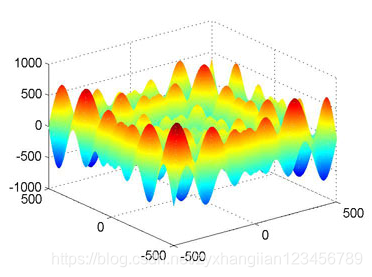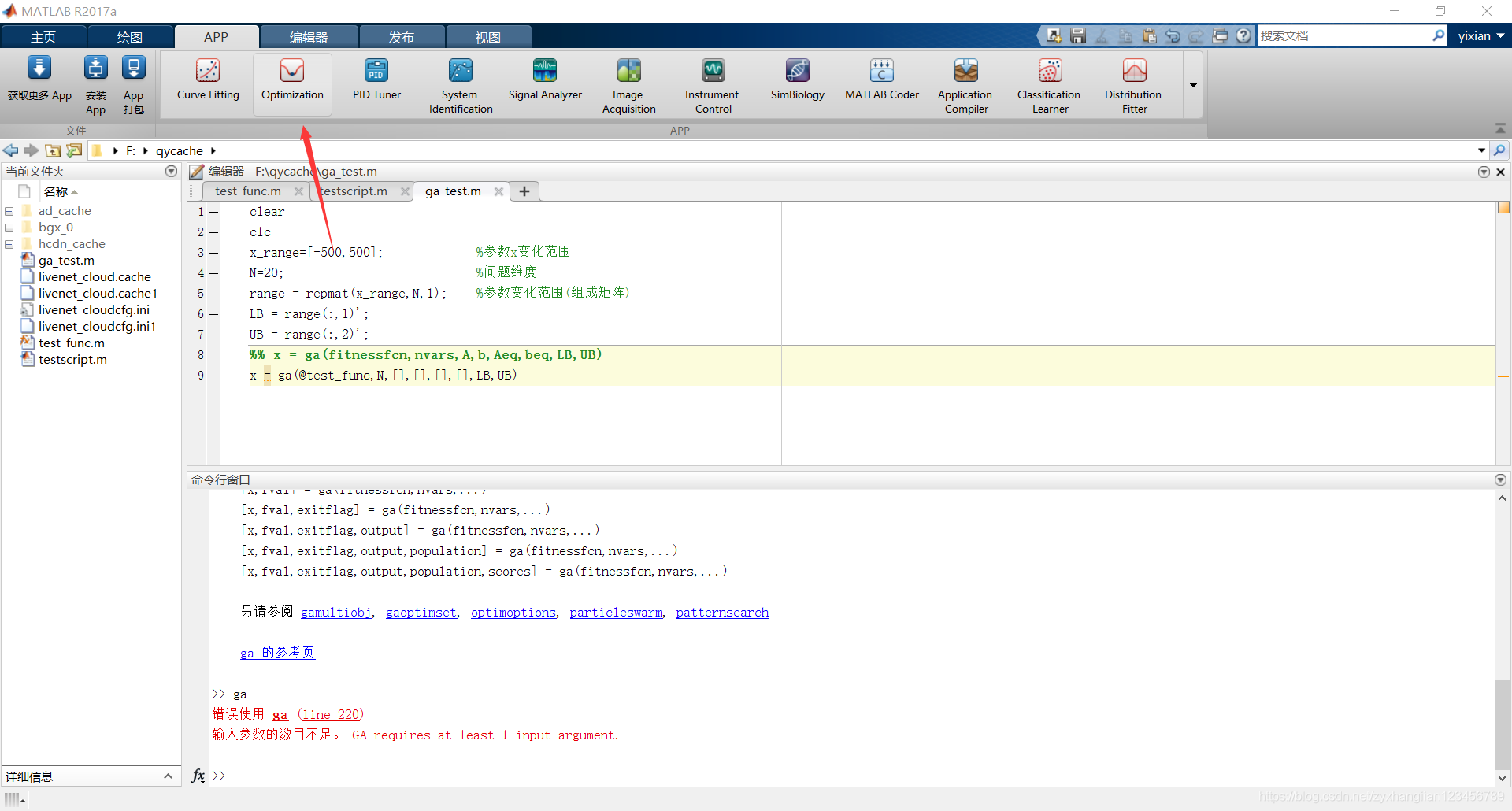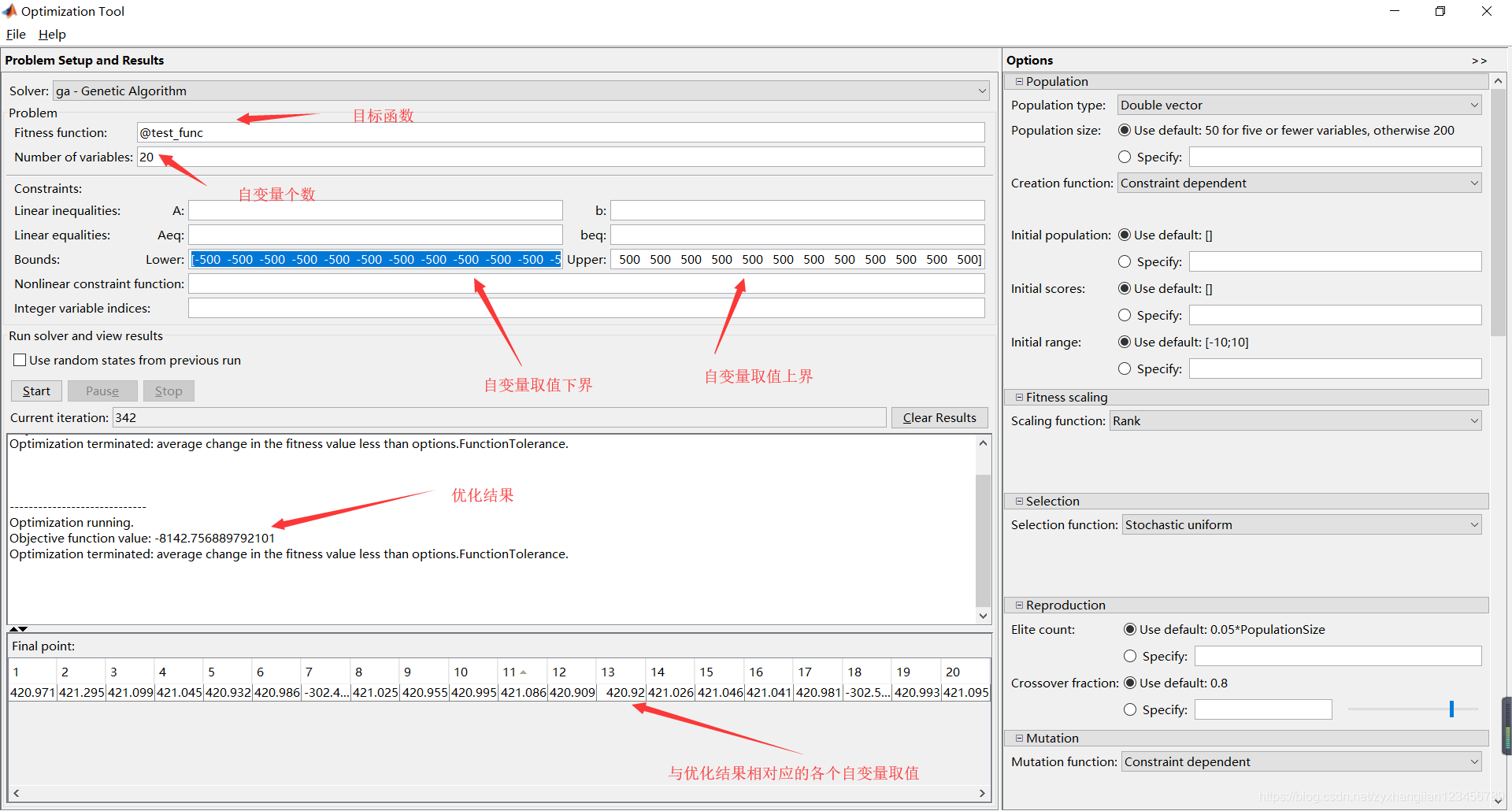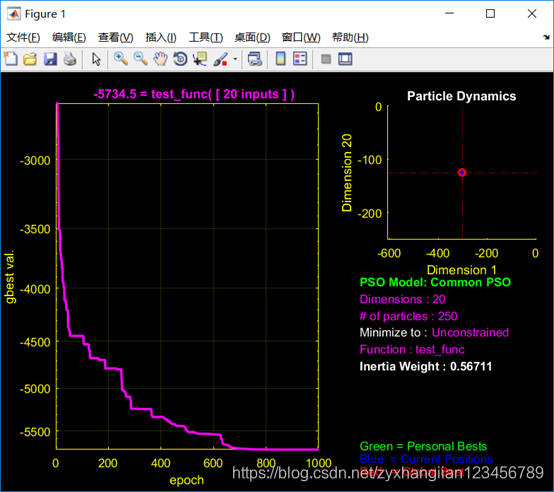产品

Schwefel's函数是一个典型的欺骗问题,有1个全局极小值点,距离另一个局部最优点很远,因此如果陷入局部最优就很难跳出。Schwefel’s函数的表达式为:

笔者将采用遗传算法、粒子群算法和差分进化算法对Schwefel’s问题分别进行求解,同时,对三种算法的结果进行对比分析。
这里,首先定义一下问题:
function z=test_func(in) z = zeros(size(in,1),1); for i=1:size(in,1) x = in(i,:); for j=1:size(in,2) temp = x(j) * sin(sqrt(abs(x(j)))); z(i,1) = z(i,1) + temp; endendz = -z;Matlab中自带了遗传算法的工具箱,通过help ga可以查看相关的帮助文档。
This MATLAB function finds a local unconstrained minimum, x, to the objective function, fitnessfcn. [x,fval] = ga(fitnessfcn,nvars,A,b,Aeq,beq,LB,UB)图形化界面操作如下:


代码求解如下:
clearclcx_range=[-500,500]; N=20; range = repmat(x_range,N,1); LB = range(:,1)';UB = range(:,2)';%% x = ga(fitnessfcn,nvars,A,b,Aeq,beq,LB,UB)[x,fval] = ga(@test_func,N,[],[],[],[],LB,UB)结果:
Optimization terminated: average change in the fitness value less than options.FunctionTolerance. x = 420.9547 421.0920 420.9799 420.9657 420.9217 421.0547 420.9840 420.9485 421.0406 421.0243 -302.3978 421.0425 421.0161 421.0313 420.9623 420.9485 421.1032 421.0249 420.9671 420.9783 fval = -8.2612e+03笔者这里设置最大迭代次数为1000,种群规模问250时,利用粒子群算法工具箱求解代码:
clearclcx_range=[-500,500]; %参数x变化范围N=20; %问题维度range = repmat(x_range,N,1); %参数变化范围(组成矩阵)Max_V = 0.1*(range(:,2)-range(:,1)); %最大速度取变化范围的10%~20%Pdef = [100 1000 250 2 2 0.9 0.4 1500 1e-25 250 NaN 0 0];%% Functname, D, mv, Varrange, minmax, and psoparamspso_Trelea_vectorized('test_func',N,Max_V,range,0,Pdef) %调用PSO核心模块运行结果:

笔者借助于Differential Evolution (DE)工具箱,进行了问题求解,具体工具箱代码可以到:https://ww2.mathworks.cn/matlabcentral/fileexchange/52897-differential-evolution-de?s_tid=srchtitle 下载。
如下是差分进化算法求解Schwefel's问题的matlab程序:
%% Problem DefinitionCostFunction=@(x) test_func(x); % Cost FunctionnVar=20; % Number of Decision VariablesVarSize=[1 nVar]; % Decision Variables Matrix SizeVarMin=-500; % Lower Bound of Decision VariablesVarMax= 500; % Upper Bound of Decision Variables %% DE ParametersMaxIt=1000; % Maximum Number of IterationsnPop=50; % Population Sizebeta_min=0.2; % Lower Bound of Scaling Factorbeta_max=0.8; % Upper Bound of Scaling FactorpCR=0.2; % Crossover Probability %% Initializationempty_individual.Position=[];empty_individual.Cost=[];BestSol.Cost=inf;pop=repmat(empty_individual,nPop,1);for i=1:nPop pop(i).Position=unifrnd(VarMin,VarMax,VarSize); pop(i).Cost=CostFunction(pop(i).Position); if pop(i).Cost<BestSol.Cost BestSol=pop(i); endend BestCost=zeros(MaxIt,1); %% DE Main Loopfor it=1:MaxIt for i=1:nPop x=pop(i).Position; A=randperm(nPop); A(A==i)=[]; a=A(1); b=A(2); c=A(3); % Mutation %beta=unifrnd(beta_min,beta_max); beta=unifrnd(beta_min,beta_max,VarSize); y=pop(a).Position+beta.*(pop(b).Position-pop(c).Position); y = max(y, VarMin); y = min(y, VarMax); % Crossover z=zeros(size(x)); j0=randi([1 numel(x)]); for j=1:numel(x) if j==j0 || rand<=pCR z(j)=y(j); else z(j)=x(j); end end NewSol.Position=z; NewSol.Cost=CostFunction(NewSol.Position); if NewSol.Cost<pop(i).Cost pop(i)=NewSol; if pop(i).Cost<BestSol.Cost BestSol=pop(i); end end end % Update Best Cost BestCost(it)=BestSol.Cost; % Show Iteration Information disp(['Iteration ' num2str(it) ': Best Cost = ' num2str(BestCost(it))]);end %% Show Resultsfigure;%plot(BestCost);semilogy(BestCost, 'LineWidth', 2);xlabel('Iteration');ylabel('Best Cost');grid on;结果:
Iteration 1000: Best Cost = -8379.6577从结果中可以看出,遗传算法和差分进化算法能够较好地求解该多欺骗问题,其中,差分进化算法表现最优,遗传算法次之,而粒子群算法容易陷入局部最优解。以上实验仅为个人的实验结果,不能作为衡量不同算法优劣的标准。
免责声明:本文系网络转载或改编,未找到原创作者,版权归原作者所有。如涉及版权,请联系删